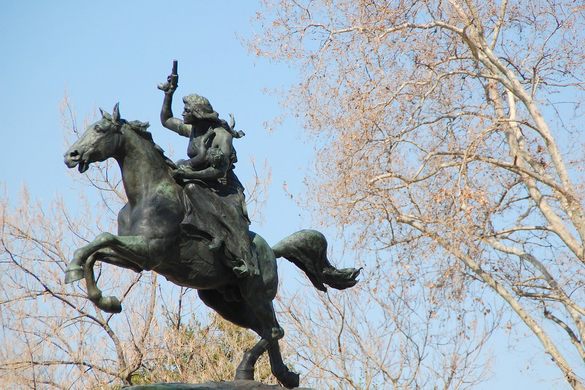AO Edited
Anita Garibaldi Monument
The Italian revolutionary's legendary wife is portrayed on horseback waving a gun and holding her child in this memorial on the Janiculum.
The Janiculum, or Gianicolo in Italian, is a wooded park that provides spectacular views over the city of Rome. It is also a monumental park planned around the theme of the short-lived Roman Republic of 1849. This experimental government, which temporarily overthrew Papal authority in Rome, fought for its survival against the French army on the fringes of the Janiculum. The legendary Italian patriot Giuseppe Garibaldi was among the key figures of the Republic’s brief existence.
There are 228 busts distributed along the park’s paths and avenues commemorating the freedom fighters of the Risorgimento—both native Italian and foreign-born—who fought and died for the unification of Italy. The busts were commissioned between 1849 and into the 1940s.
In 1895, the Italian sculptor Emilio Gallori was commissioned with the creation of an enormous equestrian monument to Garibaldi which still dominates the park. In 1932 his wife Anita Garibaldi, who was heroic and legendary in her own right, was also granted an equestrian statue.
This statue was the work of the Italian sculptor Mario Rutelli and was strongly supported by the Fascist regime (who also rejected the Vatican’s request to remove the statue of Giuseppe Garibaldi). Garibaldi met Anita during his campaigns in South America, and the two were married in Montevideo in 1842. In 1849, during the retreat from Rome, Anita died of malaria while she was pregnant with the couple’s fifth child.
Rutelli’s statue was originally meant to be larger, but it was scaled down in order to save bronze and account for the complexity of adding a child—ideological element added by the regime to strengthen the Fascist value of motherhood.
The base of the statue is decorated with bronze panels representing different episodes in Anita’s life: leading troops in the South American pampas, searching for her husband on the battlefield of Curitibanos, and being held in her husband’s arms while fleeing the Comacchio region.
The monument is also a funerary statue: on June 2, 1932, Anita Garibaldi’s remains were brought to Rome, where they were interred in her final resting place during a ceremony held on the 50th anniversary of Garibaldi’s death.























Follow us on Twitter to get the latest on the world's hidden wonders.
Like us on Facebook to get the latest on the world's hidden wonders.
Follow us on Twitter Like us on Facebook